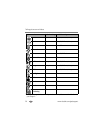
Taking pictures and videos
www.kodak.com/go/support
21
P, A, S, M, and C modes
Settings you change in P, A, S or M modes apply only to pictures taken in those
modes. Settings you change in C mode apply only to pictures taken in that mode.
For example, if you change the Color Mode to Sepia while in P, A, S, or M mode, you
still retain the default setting of Color for Auto and Scene modes.
NOTE: The settings, including Flash, are maintained for P, A, S, M, and C modes—even when you change
modes or turn off the camera. Use Reset to Default (see
page 34) to reset P, A, S, M, or C mode to
its default setting.
Aperture—also known as f-stop, controls the size
of the lens opening, which determines the depth of
field. Smaller f-numbers, for example f/2.8, refers to
a bigger lens opening. Larger f-numbers, for
example f/8, refers to a smaller lens opening.
Larger f-numbers keep the main subject sharp;
good for landscapes and well-lit conditions. Smaller
f-numbers are good for portraits and low-light
conditions. The highest and lowest aperture
numbers may be affected by optical zoom.
Children Action pictures of children in
bright light.
f/2.8–f/3.7, Multi-Pattern Exposure
Metering, Multi-Zone Focus, ISO 140
Backlight Subjects that are in shadow or
“backlit” (when light is behind
the subject).
f/2.8–f/3.7, Multi-Pattern Exposure
Metering, Multi-Zone Focus,
Fill-Flash, ISO 100
Use this SCN mode For Camera pre-settings
Aperture
Shutter
Exposure
ISO
compensation
Flash
compensation
speed
Mode setting


















